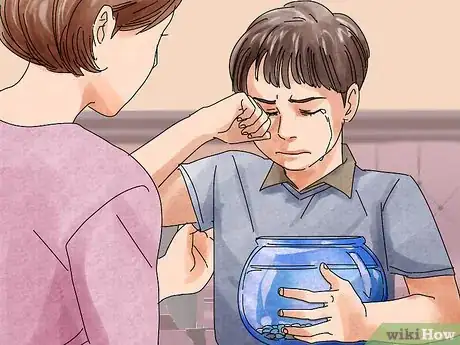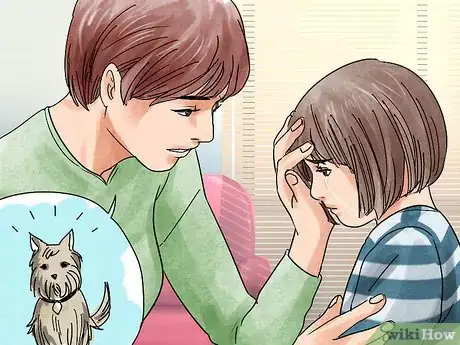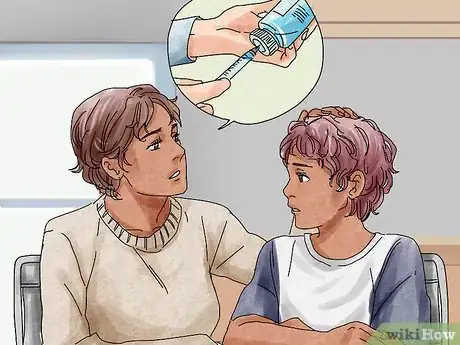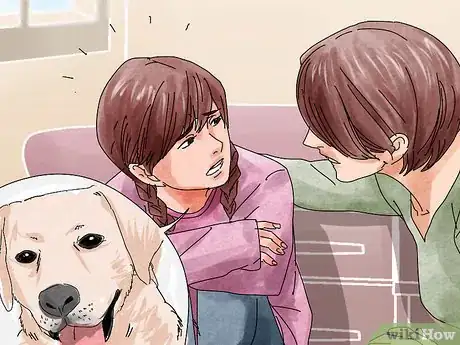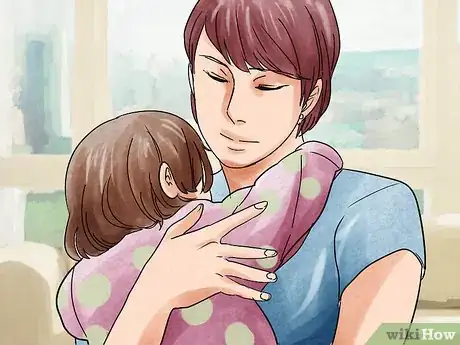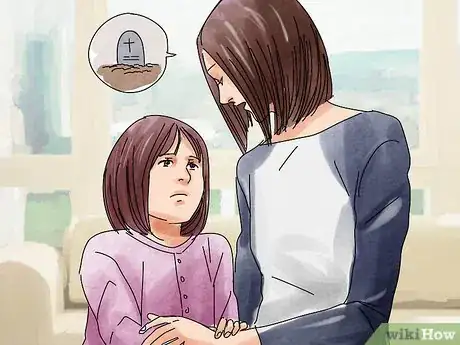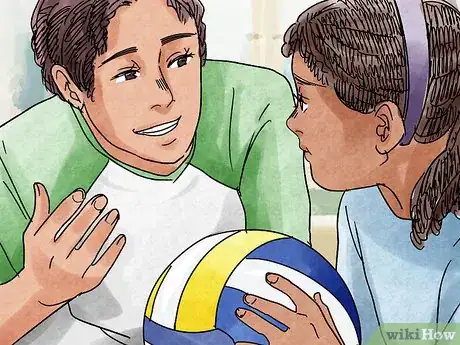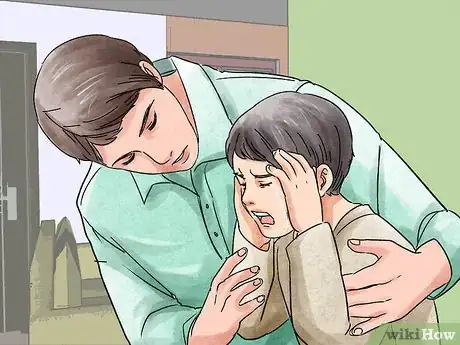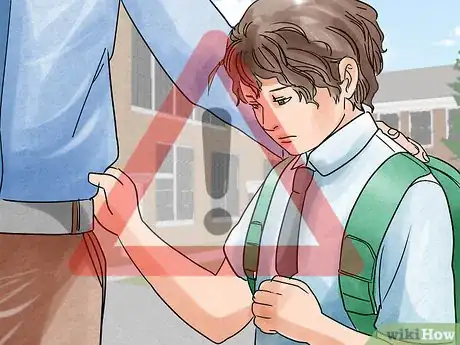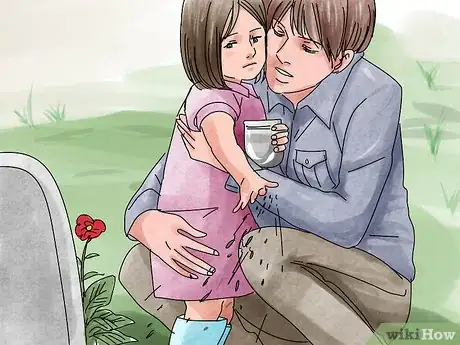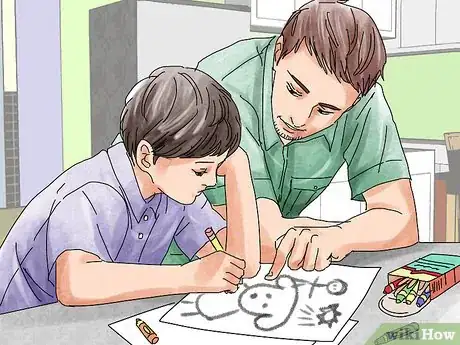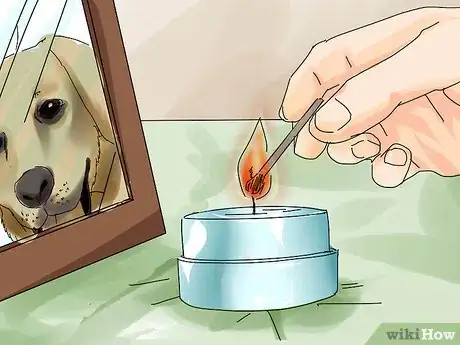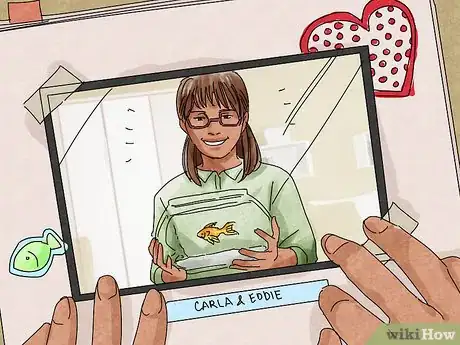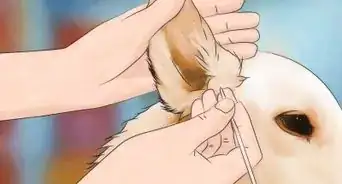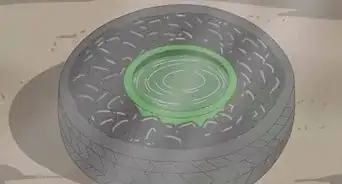This article was co-authored by Ken Breniman, LCSW, C-IAYT. Ken Breniman is a Licensed Clinical Social Worker, Certified Yoga Therapist and Thanatologist based in the San Francisco Bay Area. Ken has over 15 years experience of providing clinical support and community workshops utilizing a dynamic combination of traditional psychotherapy and yoga therapy. He specializes in eclectic non-denominational yoga guidance, grief therapy, complex trauma recovery and mindful mortal skills development. He has a MSW from Washington University in St. Louis and an MA Certification in Thanatology from Marian University of Fond du Lac. He became certified with the International Association of Yoga Therapists after completing his 500 training hours at Yoga Tree in San Francisco and Ananda Seva Mission in Santa Rosa, CA.
This article has been viewed 138,478 times.
The death of a pet is hard on anyone, but children may have an even harder time dealing with the loss of a pet. It may be difficult for your child to understand what happened and your child may struggle to deal with feelings of grief. There are several things that you can do to help your child deal with the loss of a pet including, being honest with your child, listening to your child, offering reassurance, and helping your child to preserve the pet’s memory.
Steps
Explaining a Pet’s Death to Your Child
-
1Tell your child right away. Sometimes people avoid telling children about the death of a pet right away because the conversation can be so difficult. When a pet dies, it is best to tell your child soon after it happens rather than avoiding or putting off the conversation. Your child may feel betrayed if you wait to tell him or her about the death of your pet.[1]
-
2Be honest while leaving out any details that might traumatize your child. It is important to be honest with your child and avoid using phrases like “put to sleep” and “passed away” because these expressions may confuse your child. Tell your child in a direct manner that your pet has died and that there was nothing that could be done.
- Do not share any details with your child that may be traumatic. For example, do not describe the cause of your pet’s death to your child.[2]
Advertisement -
3Explain euthanasia only if your child is ready to understand. The concept of euthanasia might be difficult for some children to understand. Other children might have an easier time understanding, but you may have to answer some difficult questions as well.[3]
- For example, your child may ask if euthanasia is like killing the animal. Do your best to provide honest answers to your child, but do not go into too much detail to avoid upsetting your child.
-
4Prepare for your child’s reaction. Your child’s reaction may vary depending on his or her age and prior experiences with death. For example, a young child may be very sad and then seem fine a few minutes later, while a teenager may respond with anger and storm off.[4]
- Keep in mind that people respond to death in a variety of different ways. Even if your child seems fine, he or she may be working through a wide range of confusing emotions.
Comforting Your Child
-
1Listen to your child when he or she wants to talk. Make sure that your child knows that you are willing to listen if he or she wants to talk. Your child may want to talk right away, in a few days, or not at all. If your child decides that he or she wants to talk, give your full attention.[5]
- Allow your child to express his or her feelings while you listen.
- Offer a shoulder to cry on if your child begins to cry.
- Reassure your child that these emotions are difficult now, but they will get better over time.
- After you have finished talking, give your child a hug.
-
2Reassure your child. Your child may express feelings of guilt or worry about the death of a pet. Some children may feel like they caused the death or like they did not treat the pet well enough while the pet was alive or that the pet could have been saved. Make sure that you reassure your child about any source of guilt that he or she may have.[6]
- For example, if your child is worried that more could have been done to save the life of the pet, reassure your child that the veterinarian did all that he or she could to save the pet’s life.
-
3Answer your child’s questions as well as you can. Your child will most likely have lots of questions about the death of a pet, especially if this is your child’s first experience with death. Do your best to answer these questions, but keep in mind that it is okay to say “I don’t know.” [7]
- For example, if your child asks questions the afterlife of animals, you may want to use the teachings of your spiritual background to help inform your answer, or you may choose to leave this more open ended and say, “I'm not sure.” You can explain what some people believe, and if you're undecided about what happens, you can tell this to your child. Then you can share with your child a picture of what you hope the pet is experiencing right now, such as having all the doggie bones he can eat without getting a bellyache, and miles of soft grass and sunshine.
- Some questions you should answer in a definite, clear way. For example, if your child asks whether or not the pet suffered when he died, then you should be honest, but aim to comfort your child. You might say something like, “Fido was in pain when he went to see the veterinarian, but the veterinarian gave him some medicine to help the pain go away before he died.”
-
4Encourage your child to maintain his or her normal routine. It might be tempting to allow your child to miss soccer practice or to skip a friend’s birthday party because he or she is feeling sad, but it is better to keep your child active and involved. If your child starts to pull away from activities and friends, this may be harmful to your child in the long run.
-
5Control your emotions around your child. Keep in mind that it is okay to cry in front of your child, but avoid letting your emotions get out of control. For example, do not sob in front of your child. This may frighten or overwhelm your child. Make sure that you excuse yourself if you begin to become overwhelmed by your emotions.[8]
-
6Watch for signs that your child may be struggling with grief. In some situations, children may have a hard time letting go of a much-loved pet. In these situations, counseling may be the best option. You can talk to your child’s school counselor to arrange a meeting or look into a therapist who works with children. Some things that indicate that your child may be struggling with grief include:[9]
- Constant sadness.
- Ongoing sadness (more than a month).
- Difficulty in school.
- Trouble sleeping or other physical symptoms that started after the death of your pet.
Remembering Your Pet
-
1Have a special ceremony to bury your pet or scatter the ashes. The process of burying or scattering a pet’s ashes can be a good way to help your child say goodbye and grieve. Plan a special ceremony to honor the life of your pet. You might even ask your child to help you plan the ceremony, if you think that he or she would like to do so.[10]
-
2Invite your child to express his or her feelings through a drawing or a letter. Your child might also find it helpful to draw a picture of the deceased pet or to write a letter to the pet that expresses how he or she feels. Ask your child if either of these activities sound appealing and offer your support.
- You can guide your child through the process by sitting nearby and offering support if he or she wants advice on what to draw or what to say in the letter.
- After your child has drawn a picture or composed a letter, invite your child to put it somewhere special, such as on the pet’s grave or in a favorite sleeping spot.
-
3Plant a special tree or flower to honor your pet. Your child may also like the idea of planting a special tree or flower in the backyard to honor your pet. Ask your child to help you pick out a tree or flower to plant. Then, choose a spot together and plant the tree or flower in your pet’s honor.
-
4Set aside a place in your home as a memorial spot for your pet. An indoor memorial can also be a great way for your child to remember a beloved pet. Try setting aside a special place for a favorite photo of the pet, such as on the mantle over the fireplace or on a small end table. Put the photo into a nice picture frame and place the photo in the special spot. Invite your child to help you light a candle next to the picture frame to help keep the memory of your pet alive.[11]
-
5Create a scrapbook of your child’s favorite memories. Ask your child to help you put together a scrapbook of favorite memories with your pet. Pick out some photos that have special significance to your child and help your child put these photos into a scrapbook. Let your child keep the scrapbook in his or her room so that he or she can always look through it to remember happy times with the beloved pet.
References
- ↑ http://www.webmd.com/parenting/features/what-say-when-pet-dies?page=2
- ↑ http://www.webmd.com/parenting/features/what-say-when-pet-dies?page=2
- ↑ http://www.webmd.com/parenting/features/what-say-when-pet-dies?page=2
- ↑ http://www.webmd.com/parenting/features/what-say-when-pet-dies?page=3
- ↑ http://kidshealth.org/parent/emotions/feelings/pet_death.html#
- ↑ http://kidshealth.org/parent/emotions/feelings/pet_death.html
- ↑ http://kidshealth.org/parent/emotions/feelings/pet_death.html#
- ↑ http://www.webmd.com/parenting/features/what-say-when-pet-dies?page=4
- ↑ http://www.webmd.com/parenting/features/what-say-when-pet-dies?page=4
- ↑ http://kidshealth.org/parent/emotions/feelings/pet_death.html#
- ↑ http://www.webmd.com/parenting/features/what-say-when-pet-dies?page=4
- ↑ Ken Breniman, LCSW, C-IAYT. Licensed Clinical Social Worker & Certified Yoga Therapist. Expert Interview. 24 April 2020.
